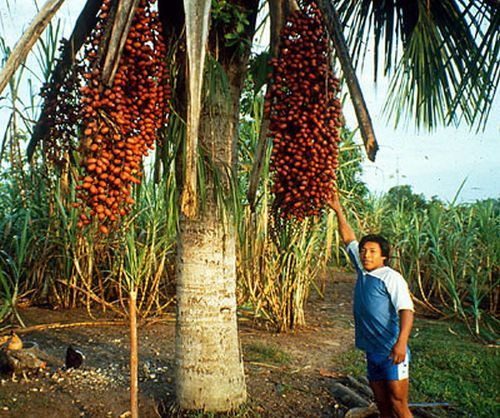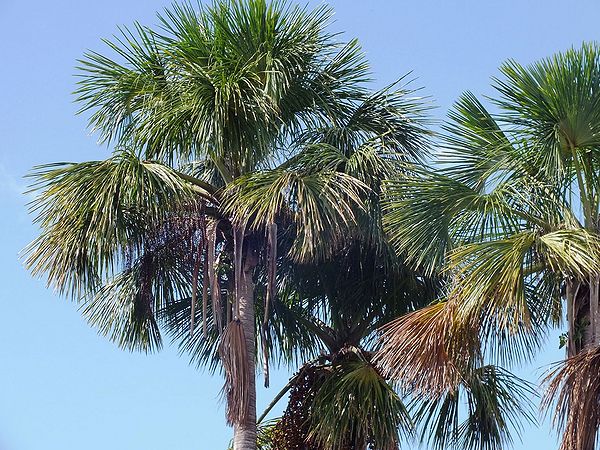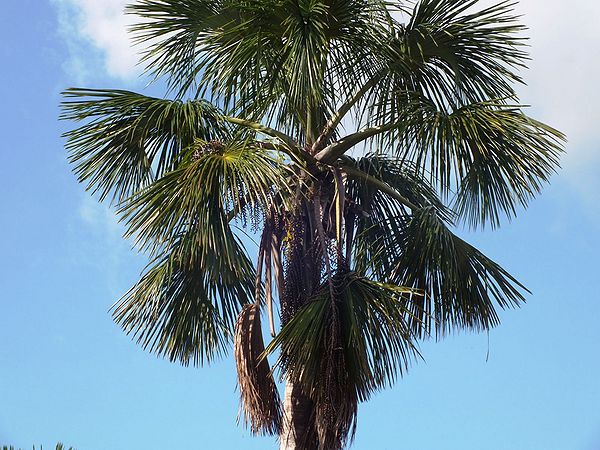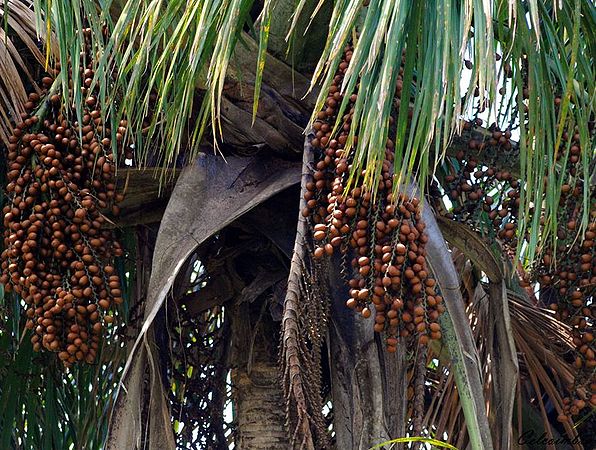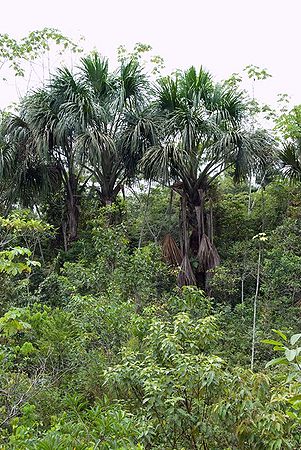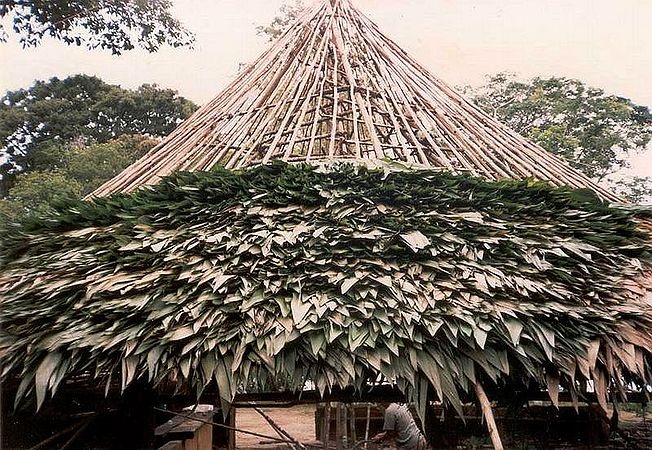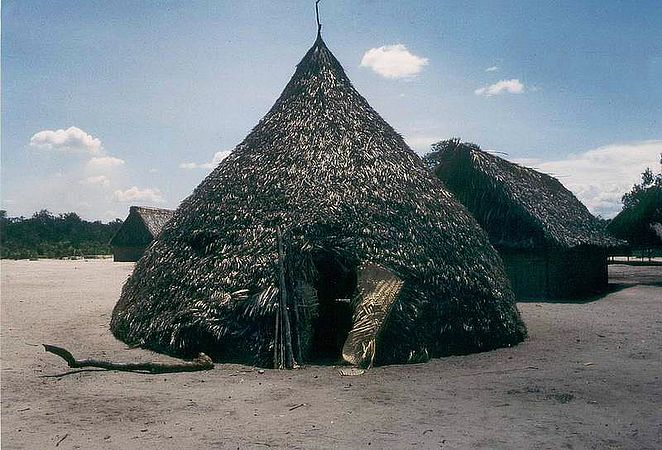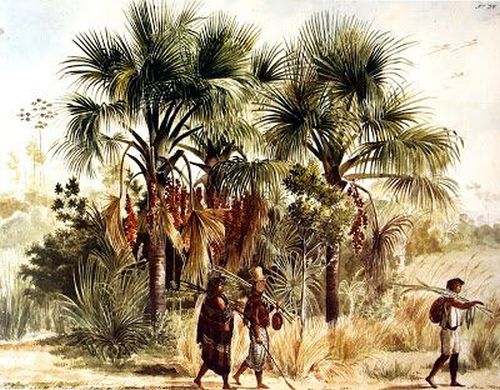Difference between revisions of "Mauritia flexuosa"
| (11 intermediate revisions by one user not shown) | |||
| Line 107: | Line 107: | ||
File:sustainable-palm-harvesting-by-climbing-aguaje-or-buiti-mauritia-flexuosa-DEMTD8.jpg|Rio Napo, Amazonia, Peru. | File:sustainable-palm-harvesting-by-climbing-aguaje-or-buiti-mauritia-flexuosa-DEMTD8.jpg|Rio Napo, Amazonia, Peru. | ||
File:mf76224891.jpg|Canaã dos Carajás, Pará, Brazil. Photo by AJArruda Brazil. | File:mf76224891.jpg|Canaã dos Carajás, Pará, Brazil. Photo by AJArruda Brazil. | ||
| + | File:mf110089734217.JPG|Chapada dos Veadeiros National Park, Brazilian HIghlands, Goias State, Brazil: Savanna biome (called cerrado in Brazil): Vereda, a treeless grassland ecosystem on semi-waterlogged soil with stands of buriti palms (Mauritia flexuosa) in wet depressions or along streams, in in valley between hills and plateaus. "Jardim be Maytreia" Photo by Jacques Jangoux | ||
| + | File:Mauritia_flexuosa90866.jpg|Queensland, Australia. Photo by Daryl O'Connor. | ||
| + | File:mara31_nMadidi National Park, Rurrenabaque, Bolivia.jpg|Madidi National Park, Rurrenabaque, Bolivia. | ||
| − | |||
| − | |||
| − | |||
File:Mauritia_flexuosa02.jpg|Trinidad, West Indies. Photo by Robert Wilson. | File:Mauritia_flexuosa02.jpg|Trinidad, West Indies. Photo by Robert Wilson. | ||
File:Mauritia_flexuosa03.jpg|Trinidad, West Indies. Photo by Robert Wilson. | File:Mauritia_flexuosa03.jpg|Trinidad, West Indies. Photo by Robert Wilson. | ||
| Line 159: | Line 159: | ||
File:2008-05-04_11-12-02.jpg|Gerardo Herrero Farm, Costa Rica. Photo by Ryan D. Gallivan. | File:2008-05-04_11-12-02.jpg|Gerardo Herrero Farm, Costa Rica. Photo by Ryan D. Gallivan. | ||
File:mfIMG_6293.JPG.5430d2b57a4bc1bc7902790f8dca4702.JPG|Searle Brothers Nursery, FL. Keith comes to visit Searle Brothers Nursery, FL. Ron Keifert giving scale. Photo by Keith. | File:mfIMG_6293.JPG.5430d2b57a4bc1bc7902790f8dca4702.JPG|Searle Brothers Nursery, FL. Keith comes to visit Searle Brothers Nursery, FL. Ron Keifert giving scale. Photo by Keith. | ||
| − | |||
| + | File:19240807213_4027e74238_c.jpg| | ||
| + | File:19240807343_a1a3827998_b.jpg| | ||
| + | |||
| + | File:mf008965.jpg|Barreirinhas, Maranhão, Brazil; 7/2012 © Sonja Germer | ||
| + | File:post-157-063405800 1291890942.jpg|Recife, Brazil. Cultivated. Photo by Gileno Machado. | ||
| + | File:5ab1a2c8e8d34_Cristalina-Gois039.JPG.40fe8f722e6db0973a8dcfeb8c501240.JPG|Syagrus graminifolia "BLUE " Its bright blue leaves are a great highlight , you recognize them miles away. See the ones on the other side of the valley, behind Buritis (Mauritia Flexuosa) Photo by Mauricio Moreira Caixeta. | ||
| + | File:5ab1675de7032_Cristalina-Gois137.JPG.a70edfb3d93f271959c40e9a8bfcca2a.JPG|Mauritia Flexuosa in habitat, in RPPN (Private Natural Heritage Reserve) Linda Serra dos Topázios. Photo by Mauricio Moreira Caixeta. | ||
| + | File:5ab1672601ed2_Cristalina-Gois169.JPG.ee590d158baa92035898e747a9dae148.JPG|Mauritia Flexuosa in habitat, in RPPN (Private Natural Heritage Reserve) Linda Serra dos Topázios. Photo by Mauricio Moreira Caixeta. | ||
| + | File:5ab167a2dc931_Cristalina-Gois168.JPG.4023f6d8b04ba72cfeace39a49553f50.JPG|Mauritia Flexuosa in habitat, in RPPN (Private Natural Heritage Reserve) Linda Serra dos Topázios. Photo by Mauricio Moreira Caixeta. | ||
| + | File:post-188-057511400 1291916439.jpg|Roraima, Brazil. M. flexosa on left, Mauritiella armata on right. Photo by Don Kittelson. | ||
| + | File:post-188-1210639328.jpg|Driving south from Boa Vista, Manaus, AM Brazil. 2008. Photo by Don Kittelson. | ||
File:buritipalm7876.jpg|Image Text: by Dr. Afonso Rabelo. Manaus, Amazonas. Brazilfrutasnativasdaamazonia.blogspot.com | File:buritipalm7876.jpg|Image Text: by Dr. Afonso Rabelo. Manaus, Amazonas. Brazilfrutasnativasdaamazonia.blogspot.com | ||
| + | File:mf65489075643.JPG|Amazonas, Brazil. See link. Photo: junglexplorer.net/peuples2_gb.htm | ||
| + | File:mf20923871166.JPG|Amazonas, Brazil. See link. Photo: junglexplorer.net/peuples2_gb.htm | ||
| + | File:mf069.jpg|Amazonas, Brazil. See link. Photo: junglexplorer.net/peuples2_gb.htm | ||
| + | File:mf070.jpg|Amazonas, Brazil. See link. Photo: junglexplorer.net/peuples2_gb.htm | ||
| + | File:mf071.jpg|Amazonas, Brazil. See link. Photo: junglexplorer.net/peuples2_gb.htm | ||
| + | File:mf062.jpg|Amazonas, Brazil. See link. Photo: junglexplorer.net/peuples2_gb.htm | ||
File:cf7cd12e6fcec0e2d5e81fc08bf6cfd2.jpg | File:cf7cd12e6fcec0e2d5e81fc08bf6cfd2.jpg | ||
image:Mf2788230.jpg|Colombia. Photo by Dr. Andrew J. Henderson/Palmweb. | image:Mf2788230.jpg|Colombia. Photo by Dr. Andrew J. Henderson/Palmweb. | ||
| Line 175: | Line 191: | ||
File:Mauritia flexuosaseeds.jpg|Photo: belizehank.com/palmseed.htm | File:Mauritia flexuosaseeds.jpg|Photo: belizehank.com/palmseed.htm | ||
image:MauFle_seeds.jpg|Rare Palm Seeds.com | image:MauFle_seeds.jpg|Rare Palm Seeds.com | ||
| + | Fruit of the Moriche Palm, used for food, flavorings, wine and oil. Native to tropical South America. A wetland species, the seeds float. Photo from eastern Ecuador. Photo by Dick Culbert. | ||
| + | |||
| + | |||
</gallery></center> | </gallery></center> | ||
==External Links== | ==External Links== | ||
| Line 185: | Line 204: | ||
*http://ethnobiology.org/sites/default/files/pdfs/JoE/15-2/Gragson1995.pdf | *http://ethnobiology.org/sites/default/files/pdfs/JoE/15-2/Gragson1995.pdf | ||
*https://youtu.be/V5W2exquxyw | *https://youtu.be/V5W2exquxyw | ||
| + | *http://www.junglexplorer.net/peuples2_gb.htm | ||
==References== | ==References== | ||
Phonetic spelling of Latin names by edric. | Phonetic spelling of Latin names by edric. | ||
Latest revision as of 23:37, 17 February 2020
| Mauritia (maw-ree-TEE-ah) flexuosa (fleks-OHS-sah) | |||||||
|---|---|---|---|---|---|---|---|
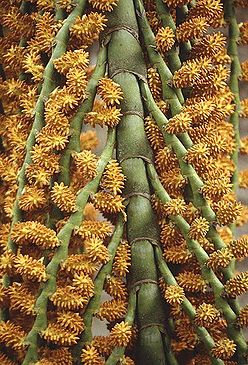 Puerto Maldonado, Brazil. Staminate rachillae. Photo by Dr. Andrew J. Henderson/Palmweb. | |||||||
| Scientific Classification | |||||||
| |||||||
| Synonyms | |||||||
|
| |||||||
| Native Continent | |||||||
|
| |||||||
| Morphology | |||||||
| |||||||
| Culture | |||||||
|
| |||||||
| Survivability index | |||||||
|
| |||||||
| Common names | |||||||
|
| |||||||
Contents
Habitat and Distribution
Characteristic of low-lying flooded areas throughout South America, distributed between approx. 14 S Lat and 14 N Latthroughout the island of Trinidad and South America east of the Andes (Bolivia, Brazil, Colombia, Ecuador, Fr. Guiana, Guyana, Peru, Surinam, and Venezuela); found at elevations below 500 m, typically growing on swampy or seasonally flooded lands with poor drainage and acid soil; often forms dense, almost pure stands with up to 645 indiv/ha.
Description
Solitary palm. Up to 35 metres in height, with petioles up to 6 m long, the large leaves form a rounded crown. Fruit is a chestnut colour and is covered with shiny scales. The yellow flesh covers a hard, oval, nut. The seeds float, and this is the means by which the palm tree propagates. In natural populations the tree reaches very high densities. Editing by edric.
Root: subterranean root branches into small, thin, absorbing roots; aerial roots have pneumatophores for oxygen uptake; can also produce many 2-10 em long erect aerial rootlets on stem ("aerial root muff"). Stem: 15-30 m tall typically 0.3-0.6 m in diam. but reported up to 1.75 m; cortex is hard, unarmed and straight with distinct internodes; middle of stem is sometimes swollen; pith is spongy, reddish in color and contains up to 60% dry weight in starch (up to 60 kg starch can be extracted); sap can be fermented to produce a wine; rotten stems (particularly male plants) inhabited by the edible Rhyncophorus sp. (Bruchidae) larva (up to 500 larvae/stem). Leaf: 10-12 per palm and restricted to a terminal crown; production 5-12 leaves/palm/ year; briefly costapalmate, approx. 3.0 m in diam. with deeply cut and glossy green blades 0.8-1.2 m long and 1.5-2.0 m wide; leaf-blades bear a low hastula-like crest ("shaped) adaxially at base and have prominent midribs; leaf-blades are 2-4 cm wide drooping at tips; last 2-3 years as thatch. Petioles 2-3 m long and conspicuously adaxially channeled near base; otherwise circular in cross-section, smooth and unarmed. Flower: dioecious, but occasionally hermaphroditic; interfoliar (originates among leaves), persistent and pendulous; 2-3 m long with numerous short, tubular bracts, and catkin-like branches; male flower has six stamens; young inflorescence produces a sap that can be fermented into wine. Pollination: known pollen transporter is Melipona seminigra merrillae (Apidae). Fruit: 5-8 fruiting panicles per tree with up to 724 fruits per panicle; productivity 6.19.1 mt fruit/ha/yr. Fruit is large, usually one-seeded and sometimes wider than long: 4 cm in diam. and up to 5 em long with depression at top; loricate pericarp: many neat vertical rows of reflexed scales, red-brown when mature; rather thick, fleshy, edible, yellowish-red mesocarp; spongy, undifferentiated endocarp; corneous, homogeneous endosperm. Average fruit weight 75 g; mesocarp represents 20.5% and endocarp 12.0% of fresh weight; moisture constitutes 67%. Mesocarp contains up to 12.0% oil, woody seed and kernel up to 4.8% oil, dry remainder of meso- and endocarp; 5.2% protein, 26.2% fat, 38.2% starch and sugar, 2.9% ash, 27.5% cellulose, 30-300 mg/100 g edible portion b-carotene (50,000-500,000 ill provitamin A), and 18.4 mg/100 g edible portion a-tocopherol (vitamin E). Seeds are used as vegetable ivory; nuts are baked, ground and consumed as abortifacent. (TED L. GRAGSON 1995)
Culture
Aguaje should be planted at least eight meters apart, preferably ten meters, and kept free of weeds, in full sun. This dioecious species grows slowly, and can be mixed with many other tree and crop species as long as it is not under shade. It tolerates some flooding, and will mature in about ten to fifteen years. Several mature male palms should be kept in the field to help maintain good fruit production from the females. Aguaje palms are commonly protected in homegardens and around villages, where they grow from discarded seeds. Due to concerns over the destruction of aguaje in the wild, the planting of aguaje in agroforestry systems is now being promoted throughout the region.
Comments and Curiosities
| read more |
|---|
|
This is a dioecious genus. Phenology: Flowers are yellowish, and appear from December to April, fruits ripens, December to June. Flowering: annually for a period of approximately 2 months during the dry season. Fruiting: annually for a period of up to 6 months during the wet season. (Wetand dry season months vary north and south of the equator.) Uses: Moriche palm fruit is edible, has a high vitamin C content, and used to make juice, jam, ice cream, and a fermented "wine". An oil high in vitamin A is extracted from the pulp and is frequently used to treat burns because of its soothing qualities. The inflorescence buds are eaten as a vegetable, and the sap can be drunk fresh or fermented (see palm wine). Threads and cords are locally produced from the tree's fibers. Buriti oil is an orange-reddish oil extracted from the fruit of the moriche palm. The oil contains high concentrations of oleic acid, tocopherols and carotenoids, especially betacarotene. Recently it has been found to filter and absorb cancer-causing UV rays from the sun. As a mild diuretic and cathartic. The mesocarp (fruit) is used in making candy and "aguajina" (soda). Milled and sifted, used in the preparation of 'Chicha', a very refreshing drink (like beer), the mesocarp is boiled with water to make a milky juice, which is fermented taken a day later, also a bitter liqueur is made from secretions, that are collected from the trunk surface dissections, cuts are made in the trunks to facilitate access for beetles (probably Rhyncophorus palmarum), Trunk lying, after a month or so it house's inside, larvae (bale) used in food fried or, as "Gamon" (a local dish) baked in young leaves. The larvae, "chontacuru", of this beetle are later extracted and consumed. Excellent hammocks and fairy good cloth, coarse hats, fishing lines, nets and other cordage, are made by the Indians from the young leaves, the rachis are used to make sieves. Fruits of Mauritia flexuosa are found in abundance in the markets. Aguaje, as the fruit is commonly known, is eaten out of hand, Fruit (mesocarp), is consumed when ripe, often boiling for a few minutes, the scales can easily be flicked off and the mesocarp eaten. Also consumed in the form of "milk", and in Iquitos, Peru, the rust-colored pulp is used as a tasty ice cream flavoring. The 'Aguaje' is probably the most important palm economically that Peru has to offer. The thick layer underneath the scalelike outer covering of the fruit is very tasty. Oil is also extracted from the seed, and used in hair treetment. Palmheart is eaten. The Yellow Macaws inhabit the Palm, it is also the site of the Green Parrots, Moose, and Troop Pigs eat their fruits between May and September. (From the Spanish) Ecology: This tree is important to many animal species, several bird species, such as the Red-bellied Macaw, Sulphury Flycatcher and Moriche Oriole, use it for nesting and food. Many ungulates, fish and monkeys depend on the fruit. The buriti, also known as the moriche palm, is a large palm tree that grows in swamp regions of South America. Natives refer to it as the Life Tree. The buriti tree bears a sweet fruit with a brown, scaly exterior and yellow pulp. The pulp is extremely rich in essential fatty acids and carotenoids, including beta-carotene. Buriti Fruit Oil is considered to be one of the richest sources of beta-carotene, with levels exceeding that of carrot seed oil. Brasilian natives treat the buriti tree as sacred because it contains the nutrients and support needed to sustain life. Natives use the oil to protect the skin and to treat a variety of skin conditions including burns and sunburn. Buriti Fruit Oil, Mauritia flexuosa, possesses the remarkable ability to nourish, moisturize and repair the epidermis and improve the elasticity of maturing skin. It is highly beneficial in formulations intended to treat and heal burns and sun damaged skin. Buriti Oil has strong antioxidant properties and protects the skin from free radical damage. "This palm is very common in open wetlands south and east of Amazon, where it´s one of the main components of the ecossystems. The native populations of those areas - who knows this palm by the name of "Buriti" - rely on this palm to get food, fiber, oil, fuel, and construction materials all the year, even when it´s too dry and there´s nothing else growing around them. For being so useful, they give this palm an almost "sacred" status. The fruits can be eaten in many ways, sweet or salty. The fleshy and yellow pulp is very tasty and nutritious, but to be more easily obtained, the fruit must be quickly boiled in hot water. It is covered with some weird scaly shell. The seeds are used for its edible oil. If I´m not mistaken, from the fruit (or is it from the liquid from the young inflorescences?) they make a fermented beverage called "Buriti wine". The trunk is used as pillars for houses, and the leaves are used to cover and isolate those houses. From the leaves, they get a strong fiber, used to make baskets and such." (Monocromatico from Rio de Janeiro) |
- IMAGE GALLERY
Chapada dos Veadeiros National Park, Brazilian HIghlands, Goias State, Brazil: Savanna biome (called cerrado in Brazil): Vereda, a treeless grassland ecosystem on semi-waterlogged soil with stands of buriti palms (Mauritia flexuosa) in wet depressions or along streams, in in valley between hills and plateaus. "Jardim be Maytreia" Photo by Jacques Jangoux
- Fruit of the Moriche Palm, used for food, flavorings, wine and oil. Native to tropical South America. A wetland species, the seeds float. Photo from eastern Ecuador. Photo by Dick Culbert.
External Links
- Glossary of Palm Terms
- MODERN BOTANICAL LATIN
- "Just To Be Clear"
- http://www.palmbeachpalmcycadsociety.com/palms/documents/MauritiaFlexuosa.pdf
- http://www.fao.org/docrep/X0451E/X0451e08.htm
- http://blogs.worldwatch.org/nourishingtheplanet/aguaje-the-amazons-new-superfruit-secret-is-out/
- http://ethnobiology.org/sites/default/files/pdfs/JoE/15-2/Gragson1995.pdf
- https://youtu.be/V5W2exquxyw
- http://www.junglexplorer.net/peuples2_gb.htm
References
Phonetic spelling of Latin names by edric.
Special thanks to Geoff Stein, (Palmbob) for his hundreds of photos.
Special thanks to Palmweb.org, Dr. John Dransfield, Dr. Bill Baker & team, for their volumes of information and photos.
Glossary of Palm Terms; Based on the glossary in Dransfield, J., N.W. Uhl, C.B. Asmussen-Lange, W.J. Baker, M.M. Harley & C.E. Lewis. 2008. Genera Palmarum - Evolution and Classification of the Palms. Royal Botanic Gardens, Kew. All images copyright of the artists and photographers (see images for credits).
TED L. GRAGSON, Ethnobiol. 15 (2):177-188, 1995.
Many Special Thanks to Ed Vaile for his long hours of tireless editing and numerous contributions.





